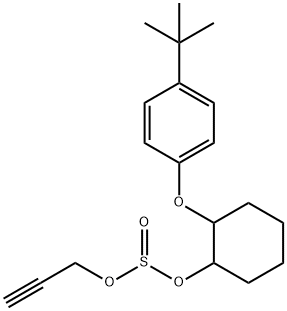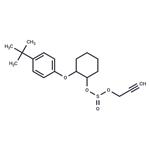Description
The pesticide omite pricipally acts as an irritant.
Contact dermatitis was reported in 40 of 47 agricultural
workers using it.
Chemical Properties
Insoluble in water.
Uses
Propargite is a pesticide used to control mite and is used on various crops from cotton to corn.
Uses
Acaricide for fruits, vegetables, row crops.
Definition
ChEBI: Propargite is a sulfite ester and a terminal acetylenic compound. It has a role as a sulfite ester acaricide.
General Description
Propargite is a dark colored liquid. Propargite is a wettable powder or water emulsifiable liquid. Propargite can cause illness by inhalation, skin absorption and/or ingestion. The primary hazard is the threat to the environment. Immediate steps should be taken to limit its spread to the environment. Since Propargite is a liquid Propargite can easily penetrate the soil and contaminate groundwater and nearby streams. Propargite is used as a pesticide. Practically insoluble in water (10.5 mg/L). Used as an acaricide.
Air & Water Reactions
Practically insoluble in water (10.5 mg/L). Slowly reacts with water to form sulfur dioxide and alcohols; reaction is more rapid under basic or acidic conditions.
Reactivity Profile
Propargite is a sulfite ester. As an ester, Propargite will hydrolyze to form sulfur dioxide and alcohols; reaction is more rapid under basic conditions. Propargite may react exothermically with acids to generate alcohols. Heat will be generated by interaction with basic or caustic solutions. Flammable hydrogen is generated by mixing with alkali metals and hydrides.
Health Hazard
INHALATION: Irritation of mucous membranes. EYES: Irritation, may be severe. SKIN: Irritation.
Flammability and Explosibility
Non flammable
Agricultural Uses
Miticide and acaricide: Pending for use in EU countries. A U.S. EPA restricted Use Pesticide (RUP). Used on a variety of bearing and non-bearing food crops and non-food sites. Grapes, walnuts, almonds, nectarines and mint are the most treated crops. Other crops include alfalfa, avocados, beans, boysenberries, carrots, cherries, citrus, corn, currants, dates, filberts, grapefruit, jojoba, grapes, hops, peanuts, sugar beets, cotton and ornamentals.
Trade name
COMITE II®; COMITE® AGRICULTURAL MITICIDE; D-014®; DIBROM OMITE®; DICTATOR®; NAUGATUCK® D-014; OMAIT®; OMITE®; OMITE® 570EW; RED-TOP®[C]; UNIROYAL® D-014; U.S. RUBBER D-014®
Contact allergens
The pesticide omite principally acts as an irritant.
Contact dermatitis was reported in 40 of 47 agricultural
workers using Omite?.
Safety Profile
Poison by skin contact. Moderately toxic by ingestion. When heated to decomposition it emits toxic fumes of SOx. See also ESTERS and SULFUROUS ACID.







